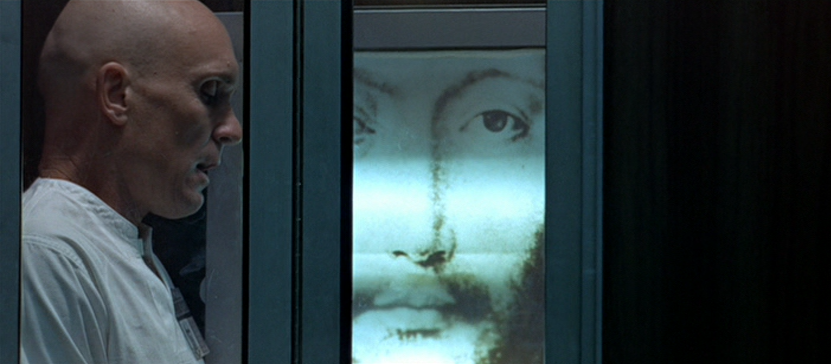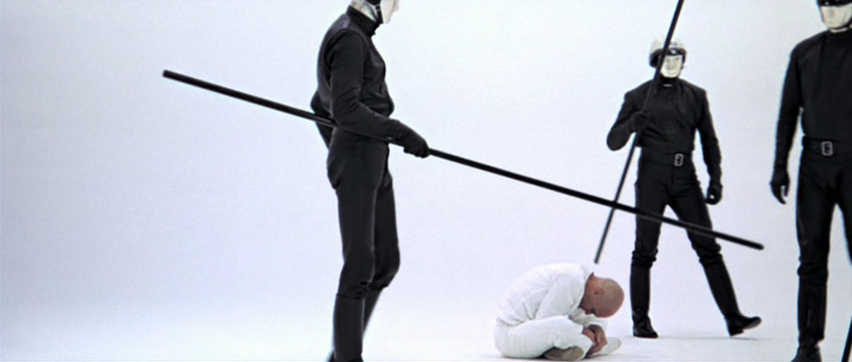

“Blessings of the state, blessings of the masses.”
Before Star Wars and The Godfather, two film school pals named George Lucas and Francis Coppola founded a production studio together. They started out in a warehouse in San Francisco with the intent of fostering innovative and unconventional approaches to filmmaking. American Zoetrope would eventually produce films by pond-hopping greats like Jean-Luc Godard, Akira Kurosawa, and Wim Wenders, along with Coppola’s most successful films, but it’s first two features were Coppola’s largely forgotten The Rain People (1969) and Lucas’s avant-garde dystopian sci-fi oddity known as THX 1138. While both films were created with the freedom of an auteurist approach characteristic of the New Hollywood movement, Lucas’s is by far the more experimental film. It’s first half hour is brilliant, and it’s visual aesthetic remains stunning throughout. Regrettably, the story does not match the strength of the film’s premise or its visual flair and the film as a whole ends up feeling a bit superficial. Nevertheless, it is a very interesting peek into the mind that launched one of the largest film franchises of all time, before delusions of grandeur stole his spark.

In Lucas’s version of the 25th century, it is not a crime to take drugs—it is a crime to not take them. Everyone wears white clothing and has shaven heads. Sexual intercourse is illegal, and emotions and the concept of a family are unfamiliar. Instead, a mechanical contraption gives citizens sexual pleasure while pornographic holograms dance in front of their eyes. THX 1138 (Robert Duvall) partakes of this activity shamelessly while his renegade roommate LUH 3417 (Maggie McOmie) is present. His senses are so dulled that he even watches the holoprojector with dead eyes while a droid beating a fellow citizen to death is presented as entertainment. Sins are confessed to an entity known as OMM, whose exhortations emit from a backlit visage of Jesus Christ. OMM speaks in a robotic voice and says things like, “Let us be thankful we have an occupation to fill. Work hard, increase production, prevent accidents, and be happy” and receives the confessions of citizens with passivity and generic words of encouragement.
The city, which is entirely underground and lit by harsh fluorescent light, is policed by humanoid androids who are thoroughly unequipped to deal with anyone who isn’t under the influence of regular sedation. So, when THX and LUH copulate and enter into a mumbled agreement to quit their sedative regimen and figure a way out of this hell, it turns into a prolonged and bizarre chase as our protagonist explores parts of the world he never knew existed and his pursuers bump up against the limits of their programming.

For my tastes, this initial setup is nothing short of brilliant. For a first time filmmaker to exhibit such panache and stylistic confidence is remarkable. We’re fed little bits and pieces to flesh out the film’s peculiar world. Walter Murch—who helped Lucas expand his short student film into the final screenplay that became THX 1138—does a fantastic job with the intricate sound design, giving us clues but not explaining things in a straightforward manner. He uses crosstalk from workers who monitor the performance of laborers, automated announcements, advertisements, and overhead chatter, much of it pitch-shifted or otherwise affected, to flesh out the dystopian world in a disconnected fashion. Some of the editing, which was done by Lucas himself, mirrors this rough, stitched-together quality of the sound to leave the viewer disoriented and lost in the bleak future world they’ve created. The shot composition varies between harsh and elegant. Sometimes we are presented with images of a monochrome screen, or shown zoomed in images of flickering waveforms, or pages moving through a typewriter, or a grid of monitors displaying shifting images. Other scenes put the wonderful, economical set design on display and achieve a very distinctive aesthetic.
The film gets quite a bit weird after its wonderful opening, often without explanation or merit. The plot, which had started with such frenetic energy, devolves into a limp thing. Donald Pleasance gives a perfectly creepy performance as SEN 5241, an eccentric programmer who attempts to arrange for THX to be his new roommate. THX and SEN are sent to prison, while LUH is “consumed” and her moniker reassigned to a fetus in a growth pod. They meet SRT 5752 (Don Pedro Colley), an actor in holograms, and try to escape from their prison. It ends with THX climbing to the surface after an exciting car chase.

As a narrative film and a social commentary, I think the film is fairly derivative. I liked the details of the world presented, but they are not startlingly original regarding their ideas. I did relish a late scene in which SEN, having followed THX out of prison but now wandering about on his own, stumbles into the presence of the image of Christ. On his knees, he seems to offer a legitimate prayer: “Things don’t seem to make sense. Sometimes I see things get left out and they don’t fit. People don’t seem to see them. Or they don’t know what to do. Sometimes a little adjustment can make all the difference. I wanna do the right thing. I wanna go back. I can start again. I can change. I can help. I just need to rest up for a little while.” One of the monks of OMM, who are shown only peripherally throughout the film, cuts him off. “This is no place for prayer,” he says. “If you want to speak to OMM, you must go to a unichapel, you know that.” It’s a shame that Lucas didn’t follow the trails that he started down here, instead pivoting into comedy and high-concept action for his subsequent two films, then taking an extended hiatus from the director’s chair. His bleak outlook as a young man certainly fits right in with other remarkable dystopian works of art. Fans of things like A Clockwork Orange or Brazil or Anthem could certainly find a lot to like here. While visually and tonally similar to Kubrick’s 2001, the message is not one of enlightenment or ascension as a byproduct of technology, but of a retreat to a primal existence outside of the societal system.
In contrast to the lacking narrative, I think Lucas’s visual style remains consistently memorable throughout and holds up remarkably well almost half a century later.1 The use of non-standard shot composition, juxtaposed with exquisitely well designed shots makes for an outstanding film in the abstract, with more in common with the French New Wave than anything that came from earlier generations of Hollywood. The innovations of this film were certainly digested by Francis Coppola, whose 1974 film The Conversation showcases a similar level of intricacy in its sonic palette and creative use of the frame. Such synergistic shoulder-rubbing amongst the giants of New Hollywood—so many geniuses constantly one-upping each other—is one of the reasons it was such an artistically fruitful time.
Regarding THX—the premise, setting, sound design and visual aesthetics are all very good, and make it fairly easy to make a case for Lucas’s status as a true visionary. I wish the narrative was just a little bit tighter in the film’s latter portion, as what substance is to be found is all abstract. But that’s an unrealistic expectation for what is essentially an expanded version of a short film. That being said, THX 1138 is certainly worth watching as a piece of cinema history. It marks Lucas’s first time as a director and is a touchstone for future films in the oeuvres of both Lucas and Coppola.2 I’m not totally in love with it, but I’m in love with the DIY, outside-the-system attitude that the confident first-time director had when creating such a radical work. I don’t care that it’s inaccessible and pessimistic; it’s bold and exciting filmmaking, and that’s always worth paying attention to.
1. I’ve never seen the original version; the one I’ve seen features Lucas’s digital tinkering in the ensuing decades, much like he has done with the original Star Wars films. I think this is limited to some of the action sequences and a few choice shots, and thus, most of the stunning sets and other visual effects appear as they did in 1971. In any case, none of it appears obtrusive; for the most part I’d describe his touch ups as very tasteful.
2. I don’t usually recommend specific versions of a film; I definitely enjoy a nice boutique edition of some niche films, but it often feels snobbish to say they’re necessarily better than another version. The best one is the one you can actually afford to see. Digression aside, the version of THX 1138 that you will want to track down contains an entire second disc of extra goodies. You can see Lucas’s short film, Electronic Labyrinth: THX 1138 4EB, as well as an hour long documentary on the history of American Zoetrope and the New Hollywood movement. Scorsese, Spielberg, Coppola, Lucas, etc. as well as a large number of other individuals are interviewed as they walk the audience through the development of the new paradigm of American cinema. It traces the early hopes for the creative freedom the rogue company promised, Lucas and Coppola’s friendship, Coppola’s seven film deal with Warner Bros. that got Lucas’s film its funding, and the studio’s exertion of control that led to Lucas’s frustration with his first few films. The dream of American Zoetrope didn’t play out the way its creators had envisioned, but New Hollywood marched on and American Zoetrope is still producing films today. It’s a very nice look at the beginning of one of my favorite eras of filmmaking.